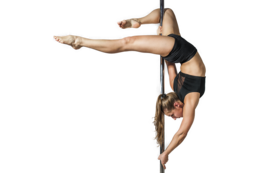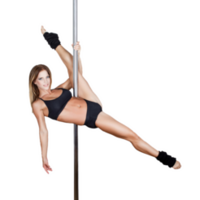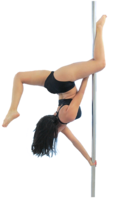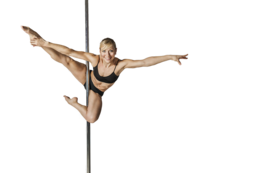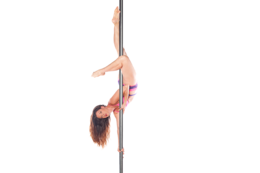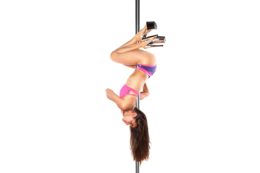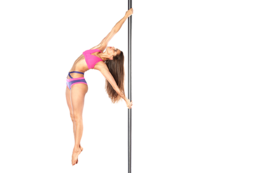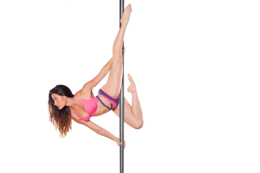In this pole dance page you can download free pole dance PNG images: pole dance PNG images free download
In this gallery of pole dance, we have 96 free PNG images with transparent background.
Pole dance combines dance and acrobatics centered on a vertical pole. This performance art form takes place not only in gentleman's clubs as erotic dance, but has also recently gained popularity as a mainstream form of fitness, practiced by many enthusiasts in gyms and in dedicated dance studios. Amateur and professional pole dancing competitions are held in countries around the world.
Pole dance requires significant muscular endurance and coordination (as well as sensuality, in exotic dancing). Today, pole performances by exotic dancers range from basic spins and striptease in more intimate clubs, to athletic moves such as climbs and body inversions in the "stage heavy" clubs of Las Vegas and Miami. Dancer Remy Redd at the King of Diamonds, for example, is famous for flipping herself upside down into a split and hanging from the ceiling. Pole dance requires significant strength and flexibility. Upper body and core strength are required to attain proficiency, proper instruction, and rigorous training is necessary. Since the mid 2000s, promoters of pole dance fitness competitions have been trying to change peoples' perception of pole dance to include pole fitness as a non-sexual form of dance and acrobatics, and are trying to move pole into the Olympics as pole sports.
Pole dance is regarded as a form of exercise which can be used as both an aerobic and anaerobic workout. Recognized schools and qualifications are now commonplace.
The standard dance pole typically consists of a hollow chrome, steel, or brass pole with a circular cross section, running from floor to ceiling. Affixing at the ceiling gives more stability, but is not always realized, especially at night clubs with higher ceilings or at transportable devices. In most countries, including the United States, the diameter is usually 50mm (2 inches), or the now more popular 45mm (1.75 inches), allowing it to be gripped comfortably with one hand. In Asia, the diameter is usually 45mm or less. In Australia a 38mm pole is popular.
There are a variety of different dance pole types to suit different performance situations. Dance poles can be permanent or portable, be different sizes, have spinning and/or static modes and they have different coatings or made from different materials.
Dance poles that are permanent are fixed to the ceiling supported by a beam located the roof and they are fixated to the floor by different brackets and bearings. The way poles are fixed to the ceiling and the floor varies by which pole brand is purchased. Portable poles are attached to a base or a portable stage and do not need to be attached to the ceiling. These poles can easily be removed, dismantled and transported into cases to different locations.
Poles come in a variety of diameters – 50mm, 48, 45mm, 42mm, 40mm and 38mm. Diameters normally depend on personal preferences and what the pole will be used for e.g. competitions or studio use.
Dance poles have two different modes, spinning and static. The spinning mode is when the pole uses ball bearings to spin. This mode can be used to complete more experienced pole moves, make moves easier to complete and to add a more dramatic effect to the move. Most spinning poles can be fixed to static too. The static mode is when the pole cannot rotate and is in a fixed position. The static mode is regularly used when pole dancing is first taught as beginners have little confidence.
Poles come in a variety of materials and coatings where each material possesses its own properties, advantages and disadvantages. The materials poles are made of are brass, titanium – gold, stainless steel and chrome. The brass and titanium – gold poles are gold in colour and are used to enhance the grip between the pole and the dancer, these poles are normally used by more advanced dancers. The stainless steel poles aren’t as popular as the other types as they do not have the finest grip however, they are used by dancers who have sensitive skin. The chrome poles are silver in colour and are most popular amongst beginners. The finishes some dance poles may possess are silicone sleeves and powder coatings. Silicone sleeves can provide maximum grip, however, there are safety precautions dancers must take and consider before using silicone sleeves. These measures can include a great amount of clothing to be worn by the dancer and only static moves can be performed. Poles that are coated in powder can provide the best friction and maximum grip for dancers.
Products such as chalk, "Dry Hands" or "iTac" may be used to help "stick" to the pole. Competitions can limit which products performers use.
